Throughout the final week of August 1835, a long article appeared in serial form on the front page of the
New York Sun. It bore the headline:
GREAT ASTRONOMICAL DISCOVERIES
LATELY MADE
BY SIR JOHN HERSCHEL, L.L.D. F.R.S. &c.
At the Cape of Good Hope
[From Supplement to the Edinburgh Journal of Science]
The article started by triumphantly listing a series of stunning astronomical breakthroughs the famous British astronomer, Sir John Herschel, had made "by means of a telescope of vast dimensions and an entirely new principle." Herschel, the article declared, had established a "new theory of cometary phenomena"; he had discovered planets in other solar systems; and he had "solved or corrected nearly every leading problem of mathematical astronomy." Then, almost as if it were an afterthought, the article revealed Herschel's final, stunning achievement. He had discovered life on the moon.
The article was an elaborate hoax. Herschel hadn't really observed life on the moon, nor had he accomplished any of the other astronomical breakthroughs credited to him in the article. In fact, Herschel wasn't even aware until much later that such discoveries had been attributed to him. However, the announcement caused enormous excitement throughout America and Europe. To this day, the moon hoax is remembered as one of the most sensational media hoaxes of all time.

Front page of the NY Sun: August 25, 1835
The moon hoax began on Friday, 21 August 1835, when a small, teaser notice appeared on the second page of the
Sun. Ostensibly copied from the
Edinburgh Courant, the announcement read, "We have just learnt from an eminent publisher in this city [Edinburgh] that Sir John Herschel, at the Cape of Good Hope, has made some astronomical discoveries of the most wonderful description, by means of an immense telescope of an entirely new principle."
This initial notice elicited no comments from rival papers. It merely served as a setup for the more elaborate series of articles (the lunar narrative) that appeared the next week, published over the course of six days as a series of extracts purportedly reprinted from a supplement to the
Edinburgh Journal of Science.
The entire lunar narrative, all six parts of it, ran to approximately 17,000 words in length. It consisted primarily of a long, rambling, and fanciful telescopic tour across the surface of the moon. It didn't have a plot or directional storyline, as such. Instead, it maintained the reader's attention by unveiling one miraculous discovery after another, constantly promising that revelations even more stupendous than those already made would soon be disclosed. It relied heavily on the premise that it was a true narrative for its sensational effect.
The
Sun printed the
first extract on Tuesday, August 25. The text of the extract occupied three-quarters of the front page. The paper's editor wrote a short note on the second page explaining to his readers what he was presenting them with:
We this morning commence the publication of a series of extracts from the new Supplement to the Edinburgh Journal of Science, which have been very politely furnished us by a medical gentleman immediately from Scotland, in consequence of a paragraph which appeared on Friday last from the Edinburgh Courant. The portion which we publish to day is introductory to celestial discoveries of higher and more universal interest than any, in any science yet known to the human race.
This first extract only briefly mentioned that Herschel had discovered any form of life on the moon. Instead, it was principally devoted to establishing the premise upon which the entire hoax depended: that Herschel had created an immense new telescope so powerful that it could be used to view astronomical objects with great clarity at previously unheard-of magnifications — or as the text said, it could be used to study "even the entomology of the moon, in case she contained insects upon her surface."
Such a telescope would, of course, have to be massive, and according to the text, it was. It measured 24 feet in diameter. By contrast, the modern telescope at California's Mt. Palomar observatory measures only 17 feet in diameter. However, its true power lay in the fact that it contained a special, second lens, the "hydro-oxygen microscope," that further magnified, illuminated, and projected the telescopic image onto a canvas screen. It was this second lens that gave the instrument its power. It did so by solving the problem of distant objects losing their light and becoming dimmer when magnified — a problem that had long plagued astronomers. By adding illumination to the telescopic image, the hydro-oxygen microscope supposedly allowed the magnification of even the most distant objects with absolute clarity.
Finally, the first extract introduced the supposed author of the narrative, a man identified as Dr. Andrew Grant, a former pupil of Sir William Herschel (Sir John Herschel's famous father, discoverer of the planet Uranus) and now the travelling companion and amanuensis of the younger Herschel. Dr. Grant, it was claimed, had written this popular account of Herschel's discoveries for the
Edinburgh Journal of Science to complement a more scholarly account that Herschel himself had transmitted to the Royal Society.
The lunar tour began in earnest in the
second extract. The narrative described the moment when, on January 10, 1835, Herschel first trained his telescope upon the moon. What appeared before his eyes was "a beautifully distinct, and even vivid representation of basaltic rock... their articulations similar to those of the basaltic formation at Staffa." Shifting the view a little bit, Herschel then perceived that the rock was "profusely covered with a dark red flower."
Having thus established that the moon contained plant life, the central question remaining was whether the moon also supported animal life. That day's narrative soon answered this question when it reported that the scientists saw herds of brown quadrupeds similar to bison, a goat "of a bluish lead color," and "a strange amphibious creature, of a spherical form, which rolled with great velocity across the pebbly beach.
The
third extract began with a description of more geological formations (oval-shaped mountains and extinct volcanoes). Dr. Grant offered a list of the variety of lunar flora and fauna seen by the astronomers up to that point: 38 species of trees, twice this number of plants, nine species of mammalia, and five of ovipara. However, the highlight of this extract was the discovery of the first sign of intelligent, though primitive, lunar life — the biped beaver. These extraordinary beavers walked on two feet and bore their young in their arms. They lived in huts "constructed better and higher than those of many tribes of human savages." And signs of smoke above the huts of the beavers indicated that these advanced animals had even mastered the use of fire.
The
fourth extract proved to be the highpoint of the entire narrative. The scientists discovered human-like creatures living inside a ring of red hills they dubbed the "Ruby Colosseum." Unlike earth-bound humans, these creatures were "covered, except on the face, with short and glossy copper-colored hair, and had wings composed of a thin membrane, without hair, lying snugly upon their backs." The faces of these creatures, Dr. Grant remarked, being "of a yellowish flesh color, was a slight improvement upon that of the large orang outang."
Further observation of these curious creatures, whom Herschel dubbed the "Vespertilio-homo, or man-bat," followed. The astronomers watched them engage in what appeared to be animated conversations and "hence inferred that they were rational creatures." The very proper Dr. Grant also noted that "some of their amusements would but ill comport with our terrestrial notions of decorum." Apparently the Vespertilio-homo were mating with each other out in the open.

An old print of the moon hoax showing the Vespertilio-Homo (center) and the Biped Beavers (right)
Anticipating that some readers would find the existence of such creatures too incredible to believe, Dr. Grant assured skeptics that a forthcoming volume would provide certificates from "several Episcopal, Wesleyan, and other ministers, who, in the month of March last, were permitted, under stipulation of temporary secrecy, to visit the observatory, and become eye-witnesses of the wonders which they were requested to attest."
The author of the lunar narrative (whoever he really was) now faced a challenge. Having revealed the existence of intelligent lunar life, how could he produce even greater wonders to maintain the interest of readers? His solution in the
fifth extract was to present readers with a mystery: the discovery of an apparently abandoned temple, built of polished sapphire. The roof of this temple was constructed out of a yellow metal and fashioned to look like a mass of flames rising upwards and licking at a large sphere of clouded copper, "as if hieroglyphically consuming it."
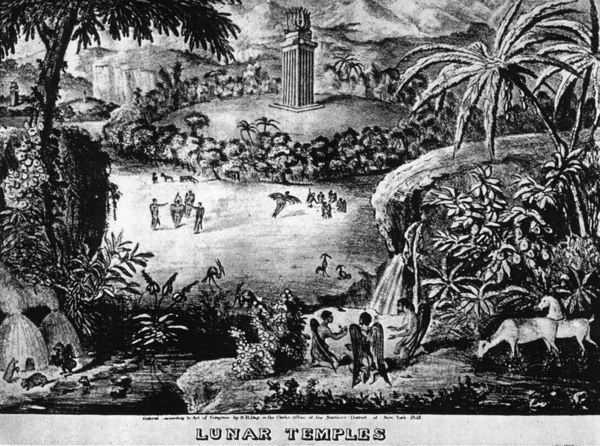
1835 print sold by the Sun showing the Sapphire Temple
The astronomers pondered what was meant by this globe surrounded by flames. Did the makers of the globe "by this record any past calamity of their world, or predict any future one of ours?" Unable to answer this question, the astronomers decided to refrain from "indulging in speculative theories, however seductive to the imagination."
The lunar narrative concluded on Monday, August 31. In the
final extract the astronomers discovered a superior order of Vespertilio-homo living in close proximity to the mysterious sapphire temple. These new creatures were "of a larger stature than the former specimens, less dark in color, and in every respect an improved variety of the race."
While observing these creatures — who spent their time collecting fruit, flying, bathing, and conversing — the astronomers realized that there reigned a "universal state of amity among all classes of lunar creatures." They couldn't remember having observed any "carnivorous or ferocious species." (Apparently they had forgotten watching birds catching fish earlier in the narrative.)

Print showing lunar creatures living peacefully side-by-side in the "Ruby Colosseum" (unknown date)
With this thought in mind, Herschel and his companions temporarily ended their observations. However, when they returned to the telescope the next day they were presented with a minor setback. They had accidentally left the telescope's lens in a position where it had caught the
Sun's rays and burned down a wall of the observatory. A week later, after having completed the repairs, the moon was no longer visible.
Dr. Grant noted that he did get a chance to briefly observe the moon again the following month, at which time he discovered a still superior species of the Vespertilio-homo who "were of infinitely greater beauty, and appeared in our eyes scarcely less lovely than the general representations of angels by the more imaginative schools of painters." But having said this much, Dr. Grant then declined to say any more, explaining to his readers that they would find a more detailed account of the highest order of Vespertilio-homo in the upcoming publication of "Dr. Herschel's authenticated natural history of this planet." With this, the narrative ended.
By all accounts, the news that life had been found on the moon generated enormous popular excitement. People throughout New York City debated whether or not the story was true and, if true, what its implications were.
Several people described this excitement in their diaries. On August 30, a young New Yorker named Michael Floy wrote in his diary, "A great talk concerning some discoveries in the moon by Sir John Herschel; not only trees and animals but even men have been discovered there." Philip Hone, the former mayor of New York, also wrote a long summary of the lunar narrative in his diary, remarking on how admirably it was written.
But we know of the excitement most of all from all the newspapers and magazines that gave it extensive coverage. By the end of August, most of the other New York papers began reprinting the narrative, in response to their readers' intense interest in it. Meanwhile, word of the discoveries quickly spread to the rest of the country, within days reaching the other major eastern cities — Baltimore, Philadelphia, and Boston. In a little less than two weeks it had travelled as far west as Cincinnati. Within a month, it had crossed the Atlantic to Europe. Everywhere the news caused the same buzz of interest and speculation.
A full month after the hoax had first seen the light of day, the
New York Herald (the
Sun's main rival) reported that the "ingenious hoax is going the rounds still. Every paper that we receive from the West brings it back again. The Bowery Theatre has dramatized it, and now Hannington [a New York museum] has actually put it on canvas, and placed it for exhibition in his diorama."
Many accounts of the moon hoax claim that popular interest in it was so great that it caused a dramatic rise in the paper's circulation, almost overnight. For instance, science writer Willy Ley wrote in
Watchers of the Skies (1963) that the hoax caused the
Sun's circulation to rise from 8000 to 19,360 copies, within the span of a few days. Similarly, a 1984 journalism textbook,
The Press and America: An Interpretive History of the Mass Media, claims that the circulation of the
Sun "nearly trebled" because of the moon hoax.
These assertions derive from a boast the
Sun made about its circulation on Friday, August 28 (the fourth day of the lunar narrative). It stated that its total circulation had reached 19,360 and then said:
We do not hesitate to say that our circulation is the greatest of any daily paper in the world, (the daily edition of the London Times being only 17,000.) Our only present difficulty is to strike off a sufficient number for the demand.
Taken alone, this statement seems to confirm that the hoax had a dramatic effect on the
Sun's circulation. However, the
Sun had made similar claims about its large circulation in the weeks before the hoax. For instance, on 13 August 1835, two weeks before publishing the moon hoax, the
Sun boasted that its circulation had reached 26,000:
Enormous Circulation — At the time of penning this paragraph—5 P.M. Wednesday afternoon—the enormous number of twenty-six thousand copies of yesterday's edition of the Sun had been issued to carriers and sold at our counter, and our publishing office is still thronged with persons waiting to be supplied:—our press, though a double cylinder, not being able to print them as fast as they have been demanded. We may safely assert that no other one paper in the Union, nor in the world, ever sold as many papers in one day, as we did yesterday.
Two statements from the Sun about its circulation. Left: Aug. 13, 1835. Right: Aug 28, 1835.
So according to the figures provided by the
Sun itself, its circulation actually dropped during the moon hoax — from a high of 26,000 before it, to 19,360 during it. However, this drop needs to be taken in context. The 26,000 copies it sold on August 13 were probably related to a one-time event — a fire that swept through parts of downtown New York City, destroying the printing press of its fiercest competitor, the
NY Herald. So people who would normally have bought the Herald may temporarily have been buying the
Sun. There had also been riots in Baltimore, which people were anxious to read about.
But although 26,000 may have represented a circulation that was higher than normal, the evidence indicates that the
Sun was regularly selling around 19,000 or 20,000 copies a day by August, 1835, and it maintained this rate during the moon hoax, apparently without experiencing a dramatic circulation spike. In its August 29 boast, the
Sun noted specifically that its circulation had been rising "within the last two months." It didn't attribute the rise to the printing of the lunar discoveries.
In fact, people didn't need to buy copies of the
Sun to read the lunar narrative because almost every paper in New York reprinted the text, making it widely available. This meant some lost sales for the
Sun, but it could hardly complain about the reprinting because it, in turn, claimed to have reprinted the narrative from the
Edinburgh Journal of Science.
Nevertheless, the
Sun did make a large profit from the moon hoax. It did so by selling the complete text of the lunar discoveries as a special-edition pamphlet that it put on sale on August 31 for one shilling. It also sold various lithographic prints showing fanciful scenes of Herschel's lunar discoveries, such as the lunar animals and the Ruby Colosseum. It commissioned the production of these prints from the Wall Street lithographers Norris & Baker.
The
Sun never shared sales figures for the pamphlet and prints, but according to William Gowans, writing in 1859, it sold 60,000 pamphlets in less than a month. This would have been a huge financial windfall for the paper. These pamphlets are now collector's items. Only sixteen of them are known to still exist, and they sell for as much as $2000 each.
The idea that the popularity of the moon hoax led to a rise in the
Sun's circulation has become a standard part of the story of the hoax. However, it turns on its head what actually happened and obscures the historical significance of the event. In fact, as Mario Castagnaro (2009) has argued, it was the
Sun's already high circulation and broad reach that ensured the success of the moon hoax — not the other way around.
The
Sun's high circulation was made possible by its use of
steam-powered printing presses. Such presses, which had only recently become available, allowed papers to print tens of thousands of copies at a cheap rate, thereby broadening their readership and turning them into a medium of truly mass communication. In addition, the
Sun used an innovative means of distribution that further broadened its reach — newsboys who sold issues on the street, shouting out the headlines for everyone to hear. The
Sun was the first paper anywhere to use newsboys to sell copies. It had started using them in 1833, less than two years before the moon hoax, so their presence on city streets was still a relatively new part of the urban environment.

Source: American Heritage (1969)
The combination of the
Sun's high circulation and the newsboys meant that everyone throughout the city, spanning all social classes, heard about the lunar discoveries at the same time. They experienced it as a shared social event in a way that was entirely new.
The importance of the
Sun's circulation can be demonstrated by comparing the lunar narrative to a similar hoax that occurred just two months prior but failed to have a similar impact. In June of 1835 Edgar Allan Poe had published a story in the first issue of a new magazine,
The Southern Literary Messenger, about a man from Rotterdam named Hans Pfall who supposedly built a balloon that carried him to the moon. Poe assured readers that his story was a factual narrative of a true event.
When the
Sun's moon hoax debuted in August, Poe became convinced that the
Sun had stolen his idea. As he later pointed out, both stories were astronomical hoaxes that had the moon as their main subject, both claimed to have obtained exclusive information from a foreign country, and both relied upon scientific detail to lend an air of plausibility. However, while the
Sun's moon hoax caused enormous excitement, Poe's story elicited hardly any interest.
One of the central reasons for the different way in which the stories were received is that the
Southern Literary Messenger had few readers whereas the
Sun had many. The
Sun broadcast its hoax out to a mass audience, and its reach was amplified when almost every paper in the city reprinted the story. Within a week close to 100,000 copies of the lunar narrative had been printed — at a time when New York City only had a population of around 300,000.
The manner in which the hoax reached such a wide audience so quickly, pushed by the power of the mass media, fascinated people. They recognized it as a great novelty. Poe himself observed:
The hoax was circulated to an immense extent, was translated into various languages — was even made the subject of (quizzical) discussion in astronomical societies... and was, upon the whole, decidedly the greatest hit in the way of sensation — of merely popular sensation — ever made by any similar fiction either in America or in Europe.
The moon hoax was the first truly sensational demonstration of the power of the mass media that had come into existence after the introduction of steam-powered printing presses. Before the 1830s, such a hoax would not have been possible.
The moon hoax foreshadowed what would eventually became a central concern about the mass media: its ability, because of its enormous reach, to shape and influence popular belief. Later hoaxes, such as the
1938 War of the Worlds "panic broadcast," would provide even more dramatic and disturbing examples of this power. But in 1835 the mass media was still new enough that most people seemed intrigued rather than concerned by this display of its power.

Lunar scene published in the Sun, September 1835
The lunar narrative wouldn't have caused as much excitement as it did if many people hadn't been willing to consider the possibility that it might be true. But how many people actually accepted it, at face value, as factual? That is, how many people fell for it outright?
It's difficult to answer this question. But accounts of the hoax, written by people who lived through it, all agreed that the overwhelming majority of the public initially appeared to accept the reality of the lunar discoveries.
Asa Greene, editor of the
New York Transcript (one of the
Sun's rivals), included one of the first published recollections of the hoax in a
travel-guide to New York City he published in 1837. According to Greene:
"The credulity was general. All New York rang with the wonderful discoveries of Sir John Herschell... There were, indeed, a few sceptics; but to venture to express a doubt of the genuineness of the great lunar discoveries, was considered almost as heinous a sin as to question the truth of revelation."
A year later, Dr. Meredith Reese, a respectable New York physician, wrote a work titled
Humbugs of New York: Being a Remonstrance against Popular Delusion whether in Science, Philosophy, or Religion, in which he included
similar remarks about the widespread belief in the hoax:
In relation to philosophical humbugs, an illustrious example is furnished by the celebrated moon story, ingeniously fabricated by a shrewd and intelligent practitioner on public gullibility, and the success of which proved, that he had rightly judged of the character of our population in regard to their readiness to swallow the most sublimated nonsense, when dignified by the name of science... There are very many in our city, who to the present hour, regard those revelations with more of reverence and confidence than any of the established truths in physics or morals.
Harriett Martineau, an English writer who was travelling through America at the time of the hoax, recorded
her impressions of the event in 1838:
"I happened to be going the round of several Massachusetts villages when the marvellous account of Sir John Herschel's discoveries in the moon was sent abroad. The sensation it excited was wonderful. As it professed to be a republication from the Edinburgh Journal of Science, it was some time before many persons, except professors of natural philosophy, thought of doubting its truth. The lady of such a professor, on being questioned by a company of ladies as to her husband's emotions at the prospect of such an enlargement of the field of science, excited a strong feeling of displeasure against herself. She could not say that he believed it, and would gladly have said nothing about it; but her inquisitive companions first cross-examined her, and then were angry at her skepticism. A story is going, told by some friends of Sir John Herschel (but whether in earnest or in the spirit of the moon story I cannot tell), that the astronomer has received at the Cape a letter from a large number of Baptist clergymen of the United States, congratulating him on his discovery, informing him that it had been the occasion of much edifying preaching and of prayer-meetings for the benefit of brethren in the newly-explored regions; and beseeching him to inform his correspondents whether science affords any prospects of a method of conveying the Gospel to residents in the moon. However it may be with this story, my experience of the question with regard to the other, 'Do you not believe it?' was very extensive."
While Martineau remembered that professors saw through the deception, Edgar Allan Poe,
writing in 1846, recalled the exact opposite:
Not one person in ten discredited it, and (strangest point of all!) the doubters were chiefly those who doubted without being able to say why — the ignorant, those uninformed in astronomy, people who would not believe because the thing was so novel, so entirely 'out of the usual way.' A grave professor of mathematics in a Virginian college told me seriously that he had no doubt of the truth of the whole affair!
William Griggs published
the longest, near-contemporary analysis of the moon hoax in 1852, seventeen years after the event. He recalled being present in New York when the hoax was first printed and standing outside the offices of the
Sun as crowds gathered there, clamoring to purchase copies of the lunar discoveries. According to Griggs, the public greeted the hoax with "voracious credulity". While he conceded there were some skeptics, most notably the
Sun's main rival, the
New York Herald, he insisted that, "the almost universal impression and expression of the multitude was that of confident wonder and insatiable credence."
Griggs added one other curious detail. According to him, not only did the public readily believe the hoax, but they were encouraged in their belief by people who came forward of their own free will to corroborate the story's details. He referred to this phenomenon as "instances of spontaneous mendacity." For instance, a Quaker gentleman apparently told the crowds gathered outside the offices of the
Sun that while he had been in London, he had personally witnessed Herschel's telescope being loaded into a ship bound for South Africa. Still others, according to Griggs, claimed to have in their possession copies of the supplement to the
Edinburgh Journal of Science and assured the doubtful that the
Sun had accurately reproduced the text of the lunar discoveries.
Finally, in 1852 an anonymous contributor to the
Southern Quarterly Review recalled the scene at Yale College when news of the lunar discoveries broke:
Yale College was alive with staunch supporters. The literati — students and professors, doctors in divinity and law — and all the rest of the reading community, looked daily for the arrival of the New York mail with unexampled avidity and implicit faith. Have you seen the accounts of Sir John Herschel's wonderful discoveries? Have you read the Sun? Have you heard the news of the man in the Moon? These were the questions that met you every where. It was the absorbing topic of the day. Nobody expressed or entertained a doubt as to the truth of the story.
From an historical point of view, these recollections represent an important source of information about the hoax, but they should be taken with a grain of salt. The "voracious credulity" of the public quickly became part of the mythology of the event and strongly influenced subsequent recollections. After all, this was a period of time in American history characterized by a rambunctious spirit of popular democracy — the Jacksonian era. While this spirit of democracy was celebrated, it simultaneously sparked fears about the credulity of the democratic masses and their ability to govern. Much of the fascination of the moon hoax lay in the fact that it dramatized these tensions and concerns.
In addition, the idea that almost everyone believed the lunar discoveries provided a dramatic punchline to the story of the moon hoax that satisfied both the supporters of the
Sun (for whom it represented the
Sun's ingenuity and wit) and its detractors (for whom it represented the lack of critical judgement of the general public). So as the story of the moon hoax was told and retold, there was little incentive for anyone to try to impartially assess the extent of belief in it. To the contrary, there was a strong incentive to exaggerate the extent of belief because this made the story far more sensational. And so the legend of the moon hoax grew.
The suspicion that belief in the lunar discoveries was not quite as widespread as frequently reported is supported when we look at the media response to the hoax, in which we find more skepticism and bemused sarcasm than voracious credulity.
On 1 September 1835, the day after printing the final extract of the lunar narrative, the
Sun made some remarks about how other newspapers had responsed to the news of the lunar discoveries. It conceded there were some skeptics, singling out the
Journal of Commerce as one of them. But it dismissed such skepticism with the comment, "Consummate ignorance is always incredulous to the higher order of scientific discoveries, because it cannot possibly comprehend them."
The
Sun then provided its readers with a list of eleven comments about the discoveries culled from other papers whom it deemed to be "competent judges of the great scientific questions now before the community." This list appeared to demonstrate widespread belief within the news community about the authenticity of the narrative. For instance, (according to the
Sun) the
Daily Advertiser wrote, "Sir John has added a stock of knowledge to the present age that will immortalize his name, and place it high on the page of science." The
Mercantile Advertiser stated, "It [the lunar narrative] appears to carry intrinsic evidence of being an authentic document." At the end of the list, the
Sun gleefully noted:
"These are but a handful of the innumerable certificates of credence and of complimentary testimonials with which the universal press of the country is loading our tables. Indeed we find very few of the public papers express any other opinion."
Subsequent accounts of the moon hoax, particularly those written during the 20th Century, took these "certificates of credence" at face value as valid evidence of the media response to the moon hoax. It was only towards the end of the 20th Century that a historian, Michael Crowe (1986), questioned the validity of the list. Crowe wondered whether the quotations were genuine, or if the
Sun had simply invented them.
An examination of archival newspaper sources reveals that the
Sun's quotations
were accurate. However, it also partially confirms Crowe's suspicions because many of the quotations were taken misleadingly out of context. For instance, the
Sun quoted the
N.Y. Commercial Advertiser as saying, "We think we can trace in it marks of transatlantic origin." It omitted the previous line where the
Commercial Advertiser declared, "We can hardly understand how any man of common sense should read it without at once perceiving the deception."
Similarly, the
Sun quoted the
N.Y. Evening Post as saying, "It is quite proper that the
Sun should be the means of shedding so much light on the Moon." It failed to mention that the
Post also wrote (in the same paragraph), "We publish the article as we find it, and do not know that it is necessary that we should accompany it with any comments to shake the faith which credulous readers may be disposed to place in its authenticity."
An analysis of New York City's leading newspapers in 1835 produces the following breakdown of moon-hoax skeptics vs. believers, which indicates that at least half of the papers greeted the lunar discoveries with skepticism:
| SKEPTICS |
- New York Herald: (James Gordon Bennett, editor). Extremely skeptical. Discussed in greater detail below.
- New York Transcript: (Asa Greene, editor). Openly skeptical. Responded with satire, claiming that through sources of their own (a "Captain Tarbox") they had obtained additional details about Herschel's lunar discoveries — namely that the lunar inhabitants were infested by nits and lice "of a bright amber color, with azure eyes, and seemed to be of a smaller species than that which infests human beings on our planet."
- New York Commercial Advertiser: (William Leete Stone, editor). Politely skeptical. Pointed out that such a massive telescope could hardly have been built without the British press commenting on it, but nevertheless praised the ingenuity of the narrative.
- Journal of Commerce: Openly skeptical. Declared, "There is no doubt but the article was manufactured in this country, and that it belongs to the same school as Robinson Crusoe and Gulliver's Travels."
- Courier and Enquirer: (James Watson Webb, editor). This was the only major New York paper that completely ignored the lunar discoveries. Given that Webb had a history of open antagonism towards the Sun, this act has to be interpreted as skepticism.
- New York Evening Post: (William Cullen Bryant, editor). Politely skeptical, stated, "[we] commend the article to our readers as one from which they will derive much entertainment whether they wholly believe it or not."
- New York Sunday News: As quoted by the Sun, it wrote, "Our doubts and incredulity may be a wrong to the learned astronomer, and the circumstances of this wonderful discovery may be correct. Let us do him justice, and allow him to tell his story in his own way." The admission of "doubts and incredulity" seems more skeptical than not.
|
| BELIEVERS |
- Daily Advertiser: This was the oldest daily newspaper in New York City. It hasn't been possible to examine the Daily Advertiser itelf, but we know it professed belief on the basis both of the quotation attributed to it by the Sun, and because the Journal of Commerce mocked "the 'respectable Daily' and the Mercantile Advertiser, each of whom, besides copying so much of the article as they could get in type for yesterday's paper, have honored it with a paragraph, expressing unbounded admiration at the discoveries it announces."
- Mercantile Advertiser: See explanation for the Daily Advertiser.
- New Yorker: (Horace Greeley, editor). According to the Sun, it stated that, "The promulgation of these discoveries creates a new era in astronomy and science generally." This seems to indicate belief.
- New York Times: Not the same NY Times as the present-day one. The Sun quoted it as saying, "the account of the wonderful discoveries in the moon, &c., are all probable and plausible, and have an air of intense verisimilitude." A little ambiguous, but we'll place it in the believers category.
|
| UNDETERMINED/AMBIGUOUS |
- Evening Star: (Mordecai Noah, editor). Response unknown.
- U.S. Gazette: As quoted by the Sun, "The article is said to be an extract from a supplement to the Edinburgh Journal of Science. It sets forth difficulties encountered by Sir John, on obtaining his glass castings for his great telescope, with magnifying powers of 42,000. The account, excepting the magnifying power, has been before published."
- New York Spirit of '76: A minor New York paper. As quoted by the Sun, "Our enterprising neighbors of the Sun, we are pleased to learn, are likely to enjoy a rich reward from the late lunar discoveries. They deserve all they receive from the public — 'they are worthy.'"
|
As the hoax spread around the nation (and world), papers tended to take their cues from whatever New York City papers they received first. For instance, on August 29 the
New Haven Daily Herald published, without editorial comment, a condensed summary of the "New Discoveries in the Moon" that it took from the
Daily Advertiser. But by August 31, having received more papers, it had become aware that the lunar discoveries might be false and noted, "Some of our editorial brethren, especially in N.York, treat the late wonderful discoveries, purporting to be made by the celebrated Herschel, as mere matter of moonshine, a complete hoax."
Among the believers were the
Albany Daily Advertiser, whose support of the
Sun was so over-the-top as to lead Ormond Seavey (1975) to suspect that the two papers were in collusion.
But nationwide, there appear to have been more skeptics than believers. The
Boston Morning Post scolded that it seemed "strange that men of sense and knowledge can have any doubt respecting this palpable hoax, or more properly imposition." The
Vermont State Paper suggested the lunar discoveries would "certainly afford amusing reading to those not disposed to yield it full credence." In South Carolina, the
Charleston Courier simply reprinted the skeptical remarks of the
Journal of Commerce under the heading, "News from the Moon — A Consummate Hoax."
By the end of September, news of the "lunar discoveries" had reached Europe. William Griggs (1852) described the reaction of European papers:
"whether they were hoaxed themselves or not, they too well knew the value of the narrative, as matter of interest to their readers, to expose its American origin, even if they were really apprised of it. As evidence of this conclusion, even the Edinburgh papers, where it must instantly have been known as a hoax, published it with all the gravity and reserve of a synod or council of sages.
From England and France these glorious and astounding discoveries sped their welcome way through Germany, Italy, Switzerland, Spain, and Portugal, and were translated into all the languages. We have recently been assured, in the most serious manner, that in many of the interior parts of Germany, and of the Continent generally, they remain uncontradicted to the present day, and are believed like sacred and delightful truths by vast numbers of the population."
However, Griggs' account seems unlikely. The few European papers from 1835 in which discussions of the lunar narrative have been found all describe it as an American hoax. For instance, the
Liverpool Mercury first reported about the narrative on September 25, 1835, under the headline: "Alleged Discovery of Men, Animals, Vegetables, &c., In The Moon." It compared the narrative to several famous eighteenth-century hoaxes, the
Native of Formosa and the Shakespeare forgeries of
William Henry Ireland.
A peculiar feature of the media response, from a modern perspective, was the relative lack of anger directed at the
Sun. Even among papers that expressed disbelief, almost none criticized the
Sun for deceiving its readers. Many actually praised the artistry and ingenuity of the narrative.
Mario Castagnaro (2009) notes, "Because readers did not yet have fixed expectations about what news was as a commodity or assumptions that it needed to be reported objectively, the fact that these stories were hoaxes did not outrage the public. Most publishers were curiously neutral, leaving it up to their readers to decide on the story's authenticity."
Castagnaro also offers this elaboration: "The early nineteenth-century was a culture of curiosity, one in which readers did not have clear-cut expectations about truth and fiction and the two usually blended together on newspaper pages; credibility was not the chief reason people picked up newspapers."
The one significant exception to the lack of outrage was the
Sun's main rival, the
New York Herald, edited by James Gordon Bennett. As noted above, the
Herald's printing press had been destroyed by fire in mid-August. But by the end of the month, Bennett had managed to find a new printer, and he returned to print on August 31, immediately calling out the
Sun in a column titled, "The Astronomical Hoax Explained."
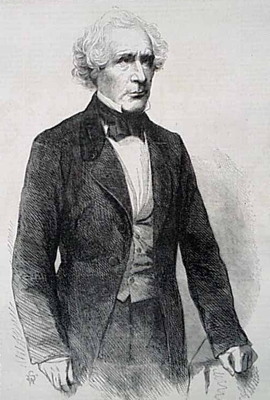
James Gordon Bennett
When the
Sun failed to confess the hoax, Bennett's anger grew, and he began to hurl invective at the
Sun, in hyperbolic terms:
"We mean now to show up the Sun — the impudent Sun — the unprincipled Sun —the mercenary Sun — the low bred Sun — the Sun that hoaxes the public — that tells untruths for money — that makes fools of the wine [sic] — that cheats the whole city and country. The revulsion of public sentiment, is fast accumulating. Its astronomical hoax will touch the Sun yet to the quick." (N.Y. Herald, Sep. 3, 1835: 2)
The next day Bennett declared the
Sun's hoax to be, "highly improper, wicked, and in fact a species of impudent swindling." Bennett only calmed his attack when he sensed that his righteous indignation was being met by public indifference.
It's unlikely that the real source of Bennett's anger was offense at the
Sun's deception. Rather, he was probably annoyed that he hadn't thought up the hoax himself. His paper (which in Sep 1835 had only been in print for three months) later became notorious for its sensationalism. He had no problem twisting the truth when it served his purpose.
The media response to the moon hoax has to be understood within the context of the newspaper business in the 1830s — specifically that there were two kinds of newspapers, penny papers and six-cent papers.
At the start of the 1830s, only six-cent papers existed, so-called because they cost six-cents an issue or ten dollars a year. They catered to a relatively narrow audience, and they had small circulations, typically lower than 2000. There were, in turn, two main kinds of six-cent papers: political papers funded by political parties, and financial papers that catered to the business community.
But as the 1830s progressed, a new kind of newspaper emerged: the penny paper. In fact, the
Sun was the very first successful penny paper in the world, started in 1833 by Benjamin Day, when he was only 23-years-old.
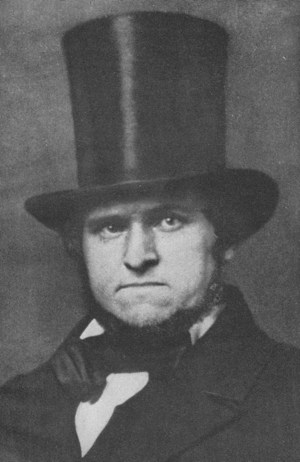
Benjamin Day
As the name suggests, penny papers cost a penny, which made them affordable to far more people. Two factors allowed for the creation of the penny press: urbanization (that created large potential markets for newspapers in cities), and the steam-powered printing press (that made it possible to print large quantities of papers very cheaply).
Unlike the six-cent papers, which got their money from subscriptions or through political funding, penny papers relied on high circulations and advertising for income. They boasted that this made them more politically independent.
To attract readers, the penny papers published content that was considered far more sensational and low-brow than what the six-cent papers were willing to run — content such as crime reports and local gossip. They also used newsboys to sell copies directly on the street. This focus on catering to the reading tastes of the average person attracted the scorn of the six-cent papers. James Watson Webb, editor of the six-cent
Courier and Enquirer, referred to the penny papers as "penny trash".
The penny papers also introduced a new policy towards advertising. The editors of the six-cent papers felt an obligation to stand behind the claims of any advertisement that appeared in their pages, but the editors of the penny press felt no such sense of obligation. They adopted a laissez-faire attitude towards advertising. They printed the ads of anyone who had the money to pay, and they left it up to their readers to decide whether an advertised claim was true or false.
What this meant, in practice, was that all variety of bizarre products soon appeared for sale in the columns of the penny press: leeches, real Indian hair restoratives, balsam of liver wort (promised to cure tightness of the chest), infallible remedies for the piles, Compound syrup of iceland moss for the cure of whooping cough, and Genuine Hygeian Vegetable Universal Medicine (whose virtues, according to its promoter, were "too well known" to require explanation). Even personal ads, placed by men attempting to meet wives, first made their appearance in the penny press.
The "penny system" (as it came to be called) eventually prevailed over the six-cent system and grew into the modern newspaper industry. But in late 1835 — by which time New York City had two other penny papers in addition to the
Sun: Bennett's
New York Herald and the
New York Transcript — the success of the penny system seemed far from guaranteed. All three penny papers were doing well, with circulations of around 15,000 to 20,000 each — far higher than their six-cent rivals. But most New York papers were still six-cent papers. This was the context in which the moon hoax appeared.
Dan Schiller (1981) has argued that Day printed the moon hoax in order to embarrass the six-cent papers, hoping they might try to steal his scoop by reprinting the story without crediting him. As it turned out, none of the six-cent papers took this bait. Although they did reprint the story, they all credited the
Sun. Nevertheless, the hoax did dramatize the difference between the conservative six-cent papers and the more rambunctious penny papers, casting the penny papers as more sharp-witted (and entertaining) than their rivals. And for this reason, the hoax proved to be a smart business move on Day's part.
Even Bennett, when he wasn't raging at the
Sun for deceiving the public, paused to note that the moon hoax reflected favorably on the penny papers as a whole:
"The Difference. — The sixpenny papers think and talk as if they were philosophers, critics, learned, intelligent men. Now mark the test. Not one of the penny papers ever believed the moon hoax — one half the sixpenny were hoaxed. The Herald at the jump was the only paper that explained the whole humbug." (N.Y. Herald, Oct. 27, 1835: 2)
The moon hoax holds a special place in the history of journalism, because its success has been widely credited with ensuring the success of the
Sun itself, and therefore, by extension, the success of the penny system and modern journalism. This may be going a bit far. The penny system would certainly have eventually overshadowed the six-cent system anyway, and it's debatable how much the hoax really helped the
Sun's circulation (see above). Nevertheless, the hoax definitely did make make a name for the
Sun, and since the public responded favorably to the hoax, viewing it as a clever joke rather than a malicious deception, it served as an excellent advertisement for the paper, and for the laissez-faire values of the penny system.
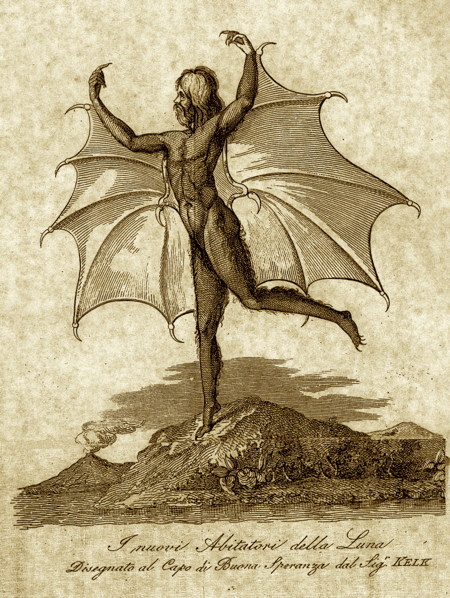
Vespertilio-Homo, from an Italian edition of the moon hoax
Although the lunar narrative may not have been met with credulity as widespread as most accounts of the hoax suggest, it certainly wasn't dismissed as a fraud out of hand. It was plausible enough to give most people pause.
This may seem strange to modern readers, since today the narrative reads like rather far-fetched science fiction. (The moon hoax is considered to be one of the first science fiction stories ever published.) So what was it about the narrative that gave it the appearance of (possible) truth? It wasn't anyone one thing, but rather a variety of factors.
The central claim of the moon hoax was that life had been discovered on the moon. Today such a claim sounds absurd — especially life of the kind described in the narrative, biped beavers and man-bats — but in 1835 there was still genuine debate about the possibility of lunar life. The scientific community was beginning to lean towards the conclusion that the moon couldn't support life, but there was no consensus on the matter yet. So on the issue of lunar life, science didn't provide the public with any clear guidance by which to judge the lunar narrative.
Throughout the eighteenth century, prominent scientists such as Gottfried Wilhelm Leibniz, Edmond Halley, and William Herschel (father of John) had strongly supported the idea that extraterrestrial life existed, even on the moon (as well as inside the hollow earth according to Halley, and on the sun according to Herschel Sr.). But by the 1830s, many astronomers had grown far more skeptical about the possibility of lunar life.
The primary reason for their skepticism was the observation that the moon sharply occulted stars. That is, when the moon passed in front of stars, the image of the stars didn't appear fuzzy as they neared the edge of the moon. Such sharp
occultation indicated that the moon lacked an atmosphere, and therefore lacked air to sustain life. As the German astronomer Friedrich Wilhelm Bessel put it in an 1834 lecture, "The moon has no air; thus also no water, because without the pressure of air, water at least in the liquid state would evaporate; thus also no fire, for without air nothing can burn."
However, the apparent lack of a lunar atmosphere hadn't convinced all scientists that the moon didn't support life. After all, what if unseen areas of the moon, such as caves, held an atmosphere? Or what if the lunar inhabitants didn't require an atmosphere to survive? For these reasons, some astronomers continued to insist that only direct telescopic observation of the moon would settle the question of lunar life, and they had been diligently scanning the surface of the moon to find any signs of life. They even believed they had met with some success.
In 1824, Franz von Paula Gruithuisen, professor of Astronomy at Munich University, had published a paper titled "Discovery of Many Distinct Traces of Lunar Inhabitants, Especially of One of Their Colossal Buildings." In this paper, he noted the existence not only of different shades of color on the lunar surface, which he correlated with climate and vegetation zones, but also lines and geometrical shapes, which he felt indicated the existence of roads, walls, fortifications, and cities.
Other prominent German astronomers during the 1820s and 30s shared Gruithuisen's belief in the existence of lunar life. Carl Friedrich Gauss (director of the Göttingen Observatory), Johann Joseph von Littrow (director of the Vienna Observatory), and Wilhelm Olbers (a Bremen astronomer) all seriously discussed ways of communicating with the inhabitants of the moon, such as the construction of gigantic geometrical symbols on the surface of the Earth that would be visible from the moon. These discussions were described in the
October 1826 issue of the Edinburgh New Philosophical Journal.
Sir John Herschel himself, to whom the moon hoax credited the supposed lunar discoveries, hadn't ruled out the possibility of lunar life. In his
Treatise on Astronomy, published in America in 1834 (one year before the moon hoax), Herschel had reviewed the arguments for and against the possibility of lunar life, but took no side in the debate. After concluding his review, he simply remarked, "Telescopes... must yet be greatly improved, before we could expect to see signs of inhabitants, as manifested by edifices or by changes on the surface of the soil."
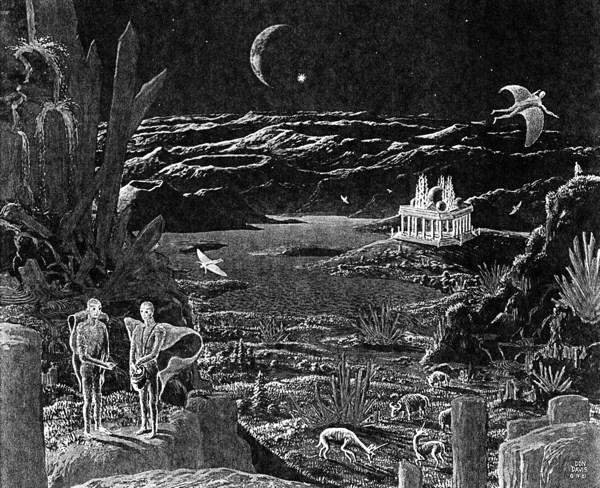
Moon hoax scene, created by artist Don Davis for Sky and Telescope magazine (1981).
The first installment of the lunar narrative described the "immense telescope of an entirely new principle" that Sir John Herschel had supposedly invented and constructed. The telescope consisted of a 24-foot diameter lens, whose power was amplified by a second lens, the "hydro-oxygen microscope". It was the extraordinary power of this telescope that allowed Herschel a clear view of the lunar inhabitants. (Perhaps the author of the moon hoax had read the passage in Herschel's book, quoted above, about improving telescopes to spy on lunar inhabitants.) This was a specific technological claim, whose plausibility readers could judge independent of the claims about lunar life.
For some readers (the more technologically astute ones) the improbability of such a telescope immediately undermined the plausibility of the entire narrative. William Leete Stone, editor of the
Commercial Advertiser, pointed out that if such a massive piece of equipment had been built, the British press would certainly have written about it before. And Michael Floy, the young New York businessman who wrote about the hoax in his diary, noted that such a telescope was impossibly far beyond the limits of optical technology:
The author of these wonders says that an enormous lens of 30 feet diameter was constructed. He thought that would be a big enough lie in all conscience, but he should have said a lens of 100 feet diameter, as it is shown by writers on optics that such a diameter would be required to ascertain if any inhabitants in the Moon. Why not make a good lie at once? But it is utterly impossible to construct a lens of half that diameter, and therefore we may despair of ever ascertaining whether the moon be inhabited.
Ironically, two years before the moon hoax, Day had run an article in the
Sun about lunar science, in which he too had pointed out that a telescope couldn't be built powerful enough to see life on the moon:
"Some of the German astronomers gave out a few years since that they had discovered cities and regular fortifications in the moon. This we may doubt without fear of being sceptical, but is recorded in works of credit that a lunar volcano was seen at midday with the naked eye in the streets of London. It is now ascertained that no telescope can be made, in the present state of science or art, which will enable us in the way of further discoveries to 'Pluck bright honor from the pale-faced moon.'" (N.Y. Sun, Sep. 11, 1933: 1.)
However, no one remembered Day's earlier article. And few people were sufficiently well versed in optics to know that a telescope of the kind described was impossible. And moreover, such skeptical considerations tended to be swept aside by the enormous faith that Americans placed in the promise of technological advance.
The first decades of the nineteenth century had produced numerous technological wonders such as steamboats, canals, railroads, the cotton gin, and improved printing presses. Soon to appear were the telegraph and the daguerrotype. It was an age when people were prepared to believe that any invention, no matter how remarkable, was possible. This technological optimism was particularly strong in New York state, home of the recently completed Erie Canal, a marvel of engineering in its own right. And people were particularly willing to accept that Sir John Herschel might have been able to construct such a telescope, since he and his father were famous throughout the world for the remarkable telescopes they built, and their astronomical discoveries.
So while for some readers the technological claims posed by the lunar narrative immediately marked it out as a hoax, to others the claims were simply more evidence of the wonder of the age in which they lived.
For many readers of the lunar narrative, scientific and technological considerations were inseparable from religious ones. In particular, there was widespread acceptance of the arguments of Natural Theology, whose proponents had been arguing for decades in favor of the existence of extraterrestrial (and lunar) life. This was an important part of the frame of reference by which readers judged the narrative.
Natural Theology was a religious philosophy which taught that the study of nature provided not only direct evidence of the existence of God, but also insight into his divine plan. This philosophy had been articulated in works such as William Paley's
Natural Theology (1801) and the
Bridgewater Treatises of the 1830s. Natural Theology was extremely popular, both among scientists and the general public, and actually served as the dominant framework for the study of nature during the first half of the nineteenth century.
The divine plan that seemed evident to most Natural Theologians, as they dug deeper into the secrets of Nature, was that God intended, through his creation, to promote life. This conclusion was strengthened as scientists realized that the more they searched, the more they found life crammed into every obscure corner of the globe. Microscopes, for instance, revealed small, life-filled worlds even inside drops of water.
Natural theologians concluded that God was clearly bountiful and plentitudinous in his Creation. He had evidently created a universe full of life. This made it seem illogical that the Creator would have surrounded the Earth with a universe full of dead planets. After all, if God's purpose was to support life, what role could lifeless planets serve in this plan? It was this logic that convinced many that the moon must indeed be inhabited, despite its apparent lack of an atmosphere.
The astronomical implications of natural theology reached a wide audience through the writings of Thomas Dick. Dick, also known as the
'Christian Philosopher' after the title of his first book, was a Scottish astronomer whose works were suffused with the concepts of Natural Theology. Like an early, Christian version of Carl Sagan, he campaigned tirelessly as both a writer and a lecturer to popularize astronomy and the concept of a "plurality of worlds."
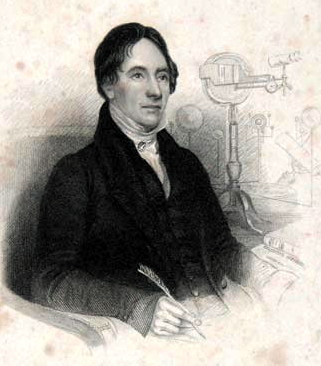
Thomas Dick, the 'Christian Philosopher'
One of Dick's more notorious achievements was his estimate of the population of the solar system. According to his calculations, the solar system contained 21,894,974,404,480 inhabitants. In fact, the moon alone, by his count, contained 4,200,000,000 inhabitants (Source: Crowe, 1997). His writings were enormously popular in the United States, with his fans including intellectual luminaries such as Ralph Waldo Emerson.
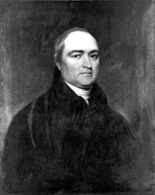
Rev. Timothy Dwight
America also had its own, homegrown proponents of Natural Theology. The most influential of these was Rev. Timothy Dwight, who served as president of Yale from 1795 until his death in 1817. He tirelessly promoted the tenets of Natural Theology. In his sermons, Dwight frequently referred to the concept of a plurality of worlds, using the idea as a means to illustrate the omnipotence of the Creator. He talked about an infinity of worlds, all governed by divinely ordained laws. He even referred in one sermon to the 'Herschellian Telescope' (meaning Sir William Herschel, not his son Sir John Herschel), and the grandeur of the inhabited universe that it revealed. Though deceased by the time of the moon hoax, Dwight's influence lived on through the students whose scientific training he had encouraged and supported. These students included Benjamin Silliman, editor of the
American Journal of Science and Arts, and Josiah Holbrook, founder of the American Lyceum movement.
Because of the popularity and influence of men such as Dwight and Dick, the Natural Theology movement laid the groundwork that made the moon hoax plausible to many people.
Perhaps the most compelling aspect of the lunar narrative had nothing to do with optics or the ongoing debate about extraterrestrial life. It was that the narrative came wrapped in the authority of European science, which Americans were very much in awe of. The discoveries were said to have been made by the renowned Sir John Herschel and had been published in the prestigious
Edinburgh Journal of Science. If this was true, then Americans were willing to consider that the narrative might be true, no matter how ridiculous it sounded. After all, who were they to question the great Herschel?
The question was, was any of this true? Had Herschel really claimed to make such discoveries? Had the narrative really been published in the
Edinburgh Journal of Science? Or was the narrative of American origin (in which case it would be obviously false)? In 1835, these questions weren't that easy to answer. It wasn't possible to pick up a telephone and call Herschel. Instead, people tried to look for clues in the narrative itself to determine its authenticity, but often these clues were misleading.
First, the narrative did pass the simplest level of fact-checking, in that people knew there really was an
Edinburgh Journal of Science, and that Herschel definitely was in South Africa, where he was charting the stars of the Southern Hemisphere. His departure from London to South Africa had been widely reported in 1833.
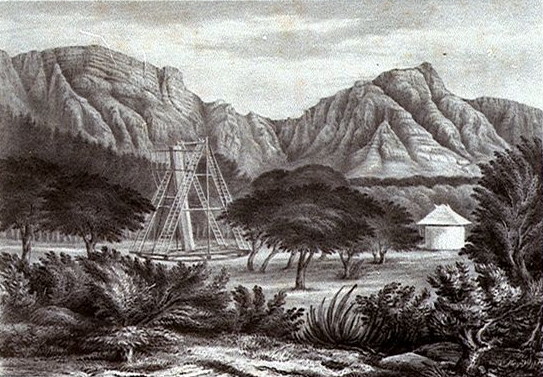
Herschel's twenty-foot reflector in Feldhausen, South Africa. Lithograph by G.H. Ford.
Second, people assessed the language and style of the story, to determine whether it sounded like something a genuine scientist would write — and here again the internal evidence proved misleading.
The narrative displayed an ornate style that included numerous scientific allusions extremely obscure to the lay reader. It did sound convincing, and it was generally doubted that any American possessed the intellectual background to have composed such a piece. In reality, quite a few Americans possessed the breadth of education and scientific experience necessary to have written it, but the general perception among Americans was that their countrymen intellectually lagged far behind the Europeans. This sense of cultural inferiority helped to convince readers that the narrative had to be of European origin, which lent credibility to the hoax.
Ironically, the fact that the narrative first appeared in the
Sun also lent weight to the belief that it was of European origin, because many people doubted that a lowbrow penny paper could have produced such an erudite text.
Third, the
Sun's explanation of how it had obtained the lunar narrative, and why they had the sole American copy, was plausible. The
Sun explained that it had obtained the journal from a "medical gentleman immediately from Scotland." European science journals were notoriously difficult to obtain copies of in America. American scientists were always struggling to get the latest journals. Because newspapers cultivated connections with dock employees in order to obtain the first news from Europe, it wasn't considered odd that the
Sun possessed the only copy of the journal in America.
Finally, there was no transatlantic cable linking America and Europe in 1835. People had to wait weeks for the mail to be shipped back and forth across the ocean. This provided the
Sun with a long window of time in which it simply wasn't possible for anyone in America to confirm whether such an article had appeared in the
Edinburgh Journal of Science. They had to take the
Sun's word for it.
The
Sun took full advantage of this window of doubt. As public suspicion grew concerning the authenticity of the discoveries, it adopted a stance of wounded innocence, claiming that it had merely published what it had received from Europe and that therefore, if there was a hoax, it was a European one. It insisted that, to settle the matter, it had to wait for the mail from Europe like everyone else:
"Certain correspondents have been urging us to come out and confess the whole to be a hoax; but this we can by no means do, until we have the testimony of the English or Scotch papers to corroborate such a declaration." (NY Sun, Sep. 16, 1835)
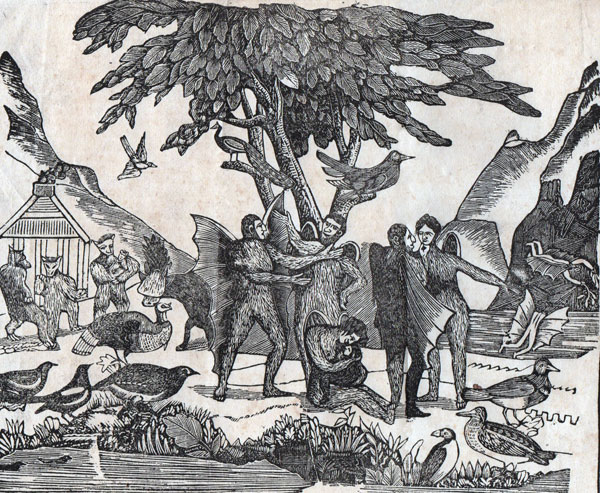
Lunar scene, from a Welsh edition of the moon hoax
The
Sun insisted it had to wait for the mail from Europe to arrive in order to determine whether the lunar narrative was a hoax. However, it supposedly had a copy of the relevant issue of the
Edinburgh Journal of Science. Why didn't it share this journal with others — show it around — in order to quell suspicions that there was no such journal? This question did occur to people at the time, and there was a report of an attempt to examine the
Sun's copy of the journal.
During the first two weeks of September 1835, a rumor spread among New York City's editors alleging that a small party of scientific gentlemen from Yale College had shown up unannounced at the
Sun's office on Nassau Street. Day asked how he could help them, and they explained that they wanted to see the
Sun's copy of the
Edinburgh Journal of Science. They said they were considering reprinting portions of the lunar narrative in a scientific publication of their own, but before they did so, they wished to verify its authenticity. Day explained that he couldn't show it to them:
"They were informed that we could not then show them the original, as it was partly divided among a number of compositors, and the remainder of it was in the hands of the lithographic artist. Dissatisfied with this answer, one of the gentlemen went, as we believe, to the office of the Journal of Commerce, and advised the editors not to insert the article [i.e. the lunar narrative] without denying or at least questioning its authenticity." (NY Sun, Sep 22, 1835: 2)
In 1852, William Griggs retold the story of the visitors from Yale, but he included new details that added a touch of comedic farce to it. According to him, after being rebuffed at the
Sun, the men headed to the printer on Spruce Street to obtain the journal there. But Day sent a messenger boy ahead of them to tell the printer to shut his office, so that the men's search for the journal was "rendered fruitless".
By the twentieth century, the story had been embellished further. Not only were the gentlemen said to be from Yale, but the deputation supposedly included the two most esteemed astronomers in America, Yale professors Denison Olmstead and Elias Loomis.
Denison Olmsted (left) and Elias Loomis (right)
It would be amusing if America's top astronomers were taken in by the lunar narrative to the extent that they traveled from New Haven to New York City to verify its authenticity. But there are reasons to doubt the story.
On September 20, the
Evening Star published a letter it had received from a correspondent identifying himself as "Yalensis". This correspondent insisted that no professors from Yale had visited the
Sun. The
Sun responded to this letter with equivocation, saying it wasn't sure the men were from Yale, only that they were from New Haven.
Perhaps the
Sun did receive a group of visitors from New Haven. However, it's just as likely the
Sun invented the story of the visit as a boast that had populist appeal — i.e., look how the lowbrow
Sun fooled the fancy professors from Yale!
It's also unlikely that Olmsted and Loomis would have been taken in by the lunar narrative. If anyone could have recognized its implausibility, it would have been them. Moreover, at the time of the moon hoax they were engaged in an important project of their own, preparing to observe the return of Halley's Comet.
In early September, Olmsted and Loomis sent a short letter to the
New Haven Daily Herald announcing that they had finally observed the comet:
"Yesterday morning, August 31st, we had the satisfaction of first observing this interesting body, in the field of Clark's great telescope. The possibility of confounding it with a nebula, induced us to wait for another observation, in order to ascertain whether it changed its place among the stars, in which case no doubt would remain of its being a comet. The approach of the twilight prevented our ascertaining this point yesterday; but observations repeated this morning, plainly indicated a proper motion; and being very near the place assigned to Halley's comet, we recognized it as the long expected visitant." (New Haven Daily Herald, Sep. 3, 1835: 2)
It's highly improbable that the two astronomers would have taken an entire day away from their observations at such a time to travel to New York City in an attempt to verify the reality of lunar biped beavers and man-bats.
The
Journal of Commerce is widely credited with being the first newspaper to suggest the lunar discoveries were a hoax. But it did so in a very general way, merely stating, "There is no doubt but the article was manufactured in this country, and that it belongs to the same school as Robinson Crusoe and Gulliver's Travels." It probably published this statement on Friday, August 28, 1835. (It hasn't been possible to find archived copies of the
Journal of Commerce from before September 1835, but its remarks were subsequently reprinted by other papers such as the
Charleston Courier.)
The hoax was much more thoroughly debunked by James Gordon Bennett when he resumed publication of the
New York Herald on August 31, 1835. In an article titled, "The Astronomical Hoax Explained," Bennett offered clear evidence that the lunar narrative had to be a hoax, and he also identified its author.
Bennett noted, "the town has been agape two or three days at the very ingenious astronomical hoax." Then he revealed a glaring mistake that revealed the whole to be a hoax. The narrative had supposedly been published in the
Edinburgh Journal of Science. But Bennett pointed out that there was, "no work of that kind being now published. A few years ago there was such a work, but it merged into another journal published in London."
Bennett was correct. The
Edinburgh Journal of Science had ceased publication in 1833. Therefore, it was impossible that it could have published the lunar narrative in 1835. Bennett's revelation should have ended the debate about whether the narrative was a hoax, but instead his disclosure was ignored by the rest of the media community.
But as for the author of the hoax, Bennett pointed the finger at a well-educated British writer, recently arrived in America, whom Benjamin Day had hired two months before to serve as the new editor of the
Sun — a man named Richard Adams Locke. This disclosure wasn't ignored.

Richard Adams Locke
During the Summer of 1835, a small-time religious leader named 'Matthias the Prophet' had been put on trial for the murder of one of his followers. It was a sensational trial, full of scandalous revelations, and the penny papers had given it extensive coverage. Bennett recalled meeting Locke during this trial, who was there to cover it for the
Sun. Bennett claimed that he had struck up a casual conversation with Locke during which Locke "told me he was engaged on some scientific studies. He mentioned optics, and I think astronomy, as the particular branches." Bennett offered this remembered conversation as proof that Locke had to be the author of the moon hoax.
Bennett also shared a bit of scandal from Locke's past, revealing that the man had originally considered dedicating his life to the Church, "but in consequence of some youthful love affair, getting a chambermaid in some awkward plight, abandoned religion for astronomy."
Bennett's evidence implicating Locke as the author of the lunar narrative was a bit flimsy. But on the other hand, Locke was the natural suspect. There were only two people working at the
Sun: Benjamin Day and Locke. Of the two, Locke was far more highly educated. He claimed to have graduated from Cambridge, and to be a direct descendant of the famous 17th-century philosopher John Locke. So, if one assumed that the lunar narrative was a hoax, it wasn't hard to guess which of the two men at the
Sun must have written it.
Locke didn't reply to Bennett's accusations in the
Sun. Instead, he sent a letter to the
Evening Star in which he declared, "I beg to state, as unequivocally as the words can express it, that I did not make those discoveries." He also complained that the story about him and a chambermaid was "as untrue as it is impertinent."
Bennett responded by pointing out, correctly, that he never claimed Locke had made the discoveries: "We only said he did the writing part." Bennett added:
"He need not be ashamed of it, neither need he squint so awfully at us about the chamber-maid. We can return the look with seven per cent interest. We still persist in our belief." (NY Herald, Sep.1, 1835)
Over the next few weeks, a battle of words raged between the
Sun and the
Herald. Locke and Day refused to admit that the lunar narrative was a hoax. Even by late September, when the mails from Europe had confirmed that the narrative was pure fiction, the two men maintained their innocence. This infuriated Bennett, who took every opportunity he could find to goad and ridicule Locke, in an attempt to get him to lose his composure and confess.
For instance, in late September Bennett declared that, "Mr. R.A. Locke, the ingenious author of the 'Moon Hoax,' is preparing a series of lectures on Astronomy, to be delivered at as early a day as possible, in the lecture-room of the Clinton Hall." Of course, Locke wasn't preparing any such lectures, but Bennett kept up the joke for weeks, constantly asking when Locke would be ready with his astronomy lectures.
In mid-November, Bennett claimed he had received a confession from Locke, in the form of a letter signed, "Richard Adams Locke, Author of the Lunar Discoveries." Locke responded that the letter was "an outrageous and felonious forgery." To which, Bennett retorted:
"Master Richard Adams and his associates of the Sun, bawl out 'an outrageous and felonious forgery'—'most malicious and libelous.' Oh! oh! oh! Why did you not think of morals when you forged the name of Herschell? Come forward good people all ye that believed in the Lunar Hoax—won't you sympathise with the Sun and Sir Richard Adams Locke in this new calamity? Will no one move? no one budge? No indeed, every one seems most inclined to laugh." (NY Herald, Nov.17, 1835).
Even in December, almost four months after the hoax, Bennett was still inserting snide comments about Locke and the moon hoax into his columns. When New York City was in the grip of a fierce ice storm, Bennett joked:
"Sir Richard Adams Locke is preparing a magnificent burning glass of one hundreds tons for the purpose of melting the ice in the North River and canals, and permitting the embargoed flour to reach the city.—A benefactor of the human race!" (NY Herald, Dec.10, 1835)
And still Locke and Day refused to confess.
Locke was born on September 22, 1800 in the county of Somerset, England to a well-to-do family. His grandfather, Richard Locke, had acquired a sizeable fortune through farming, by buying poor land and using scientific techniques to improve it. Locke would later claim that he was a direct descendant of the philosopher John Locke, but this wasn't true. He was a collateral descendant. His great-great-great-grandfather was John Locke's uncle.
As a young gentleman, it was expected that Locke should attend attend either Oxford or Cambridge (his father went to Oxford) and then take on the responsibility of managing the family estate. But at a young age Locke adopted radical Republican political views, and he decided not to follow the career his family had planned for him, for which reason his father disowned him.
Instead, Locke chose to be a writer. He first wrote for a radical newspaper, the
Republican, and several literary journals. Then he briefly served as editor of a small Somerset paper, the
Bridgwater and Somersetshire Herald, but was fired because of his politics.
Locke struggled along working as a freelance writer, but his responsibilities increased when he married in 1826 and in 1830 his wife gave birth to a daughter. Still finding it difficult to find work because of his political views, in 1831 Locke decided to move his family to America, where his politics would be a non-issue. He arrived in New York City with his wife and daughter on January 13, 1832.
In New York, Locke initially found occasional work as a legal reporter and stenographer. He also began telling people he had graduated from Cambridge, in an apparent effort to make himself appear more distinguished, and thus employable. Matthew Goodman (2008) has determined that Locke never attended Cambridge. However, because he had an extremely intellectual demeanor and was highly knowledgeable about a range of subjects, historical and scientific,
everyone in America accepted his claim about his education. A description of Locke written by Edgar Allan Poe demonstrates how he was viewed by his American colleagues:
He is about five feet seven inches in height, symmetrically formed; there is an air of distinction about his whole person — the air noble of genius. His face is strongly pitted by the small-pox, and, perhaps from the same cause, there is a marked obliquity in the eyes; a certain calm, clear luminousness, however, about these latter, amply compensates for the defect, and the forehead is truly beautiful in its intellectuality. I am acquainted with no person possessing so fine a forehead as Mr. Locke.
In 1834, Locke landed his first regular job in New York City as the metropolitan reporter for the
Courier and Enquirer. He also authored a small pamphlet,
The History of the Polish Revolution.
During the following summer, 1835, Locke was covering the trial of Matthias the Prophet, and it was here that he first met Benjamin Day, who was looking for someone to cover the trial for the
Sun. Locke agreed to provide him with a series of articles, provided his name didn't appear on them as the author, since he was still working for the
Courier and Enquirer. Day agreed.
Locke's Matthias articles proved so popular with the
Sun's readers that Day issued them as a sixteen-page pamphlet, which sold 10,000 copies. This proved to be an eye-opening experience for Day, who realized that a great deal of money could be made by reissuing material from his paper in pamphlet form — though it had to be the right kind of material. He told Locke that he would pay him for any other long articles he might write, and Locke set to work thinking of other topics he could write about in serial form. He came up with the idea of an astronomical satire detailing the discovery of life on the moon.
At the end of June, Day's co-editor on the
Sun, George Wisner, quit, and Day hired Locke as his replacement. Two months later, the
Sun published Locke's lunar narrative.
When Bennett exposed Locke as the author of the lunar narrative, Locke responded by publicly denying the charge. But according to a story first told by Frank O'Brien (1928) in his history of the
Sun newspaper, Locke admitted to a fellow reporter in private that he had written it.
According to O'Brien, Locke was having a drink in the taproom of the Washington Hotel with a fellow reporter named Finn, who worked at the
Journal of Commerce. Finn mentioned that the Journal was planning to reprint the lunar narrative. Locke said, "Don't print it right away. I wrote it myself."
The story, though anecdotal, is plausible because Locke had a reputation as a heavy drinker, and it might be the reason why the
Journal of Commerce was among the first papers to identify the lunar narrative as a hoax.
However, this wasn't the only time Locke confessed.
Locke left the
Sun in the Fall of 1836 to work at the
New Era, a new penny paper. In an article (about poetry) that he wrote soon after arriving at the
New Era, he added the title "Author of the Moon Hoax" to his byline. This was the first time he publicly acknowledged being the author of the hoax.
While at the
New Era, in the winter of 1838, Locke also attempted to perpetrate another hoax. He claimed to have discovered the lost diary of Mungo Park, the Scottish explorer who had disappeared in Africa in 1806. However, this hoax fell entirely flat. No other papers bothered to mention it. As Edgar Allan Poe later noted, "Mr. Locke's columns were a suspected district."
Locke left the
New Era in October 1839 and returned to freelancing. While looking for work, he responded to an invitation offered by Park Benjamin, editor of the
New World, to tell his side of the moon hoax. He did so in a long letter that appeared on the front page of the
New World on May 16, 1840. This was his fullest and most public confession.
Locke explained that he had intended the lunar narrative to be a satire, not a hoax at all, and that the object of his satire was the unchecked influence of religion upon science. This influence led, he believed, to an "imaginative school of philosophy" that substituted airy fancies, pleasing to religion, for hard fact. For Locke, such "theological and devotional encroachments upon the legitimate province of science" were particularly evident in the works of Thomas Dick, the 'Christian Philosopher' who had calculated the population of the solar system, as well as those German astronomers such as Gruithuisen who had claimed to see signs of life on the moon.
Locke's direct inspiration appears to have been the
October 1826 issue of the Edinburgh New Philosophical Journal in which there was a discussion of the lunar-life beliefs of the German astronomers, as well as an article by Thomas Dick in which he described his invention of a new telescope that he called the "Aërial Reflector".
Thomas Dick was aware of the moon hoax and (probably sensing that it was a joke aimed largely at himself) he offered his thoughts on it in a book he published in 1838,
Celestial Scenery; or, the Wonders of the Planetary System Displayed, Illustrating the Perfections of Deity and a Plurality of Worlds. Dick scolded the author of the moon hoax for taking liberties with the truth:
"It ought to be remembered that all such attempts to deceive are violations of the laws of the Creator, who is the 'God of Truth,' and who requires 'truth in inward parts;' and, therefore, they who wilfully and deliberately contrive such impositions ought to be ranked in the class of liars and deceivers."
In his letter to the
New World, Locke, in turn, responded to Dick:
"I think it quite laudable in any man to satirize, as I did, that school of crude speculation and cant of which he is so eminent a professor... But what has Dr. Dick to say in defence of his own hoaxes, which were chiefly instrumental in preparing the way for mine, and without which I cannot conceive that it could have obtained so instantaneous and extraordinary a circulation?"
In 1842, Locke gave up journalism and took a job with the Customs Service in New York. To get the job, he had to tell another lie: that he was born in America. He worked there until 1862, and then he spent the final years of his life living in retirement on Staten Island. He died on February 16, 1871. The following, brief obituary for him ran on the front page of the
Sun:
"Richard Adams Locke died on Staten Island on Thursday, in his 71st year. Mr. Locke was the author of the 'Moon Hoax,' the most successful scientific joke ever published, which originally appeared in The Sun. The story was told with a minuteness of detail and dexterous use of technical phrases that not only imposed upon the ordinary reader, but deceived and puzzled men of science to an astonishing degree." (NY Sun, Feb. 18, 1871: 1)
One of the features of the lunar narrative that was often remarked upon and admired was the way it wove together accurate (and often quite obscure) astronomical references with more farcical elements. It appeared to have been written by someone with a good background in astronomy. For instance, David Evans (1981) singled out the following passage, from the second day's extract of the narrative, for comment:
They arrived, after an expeditious and agreeable passage, and immediately proceeded to transport the lens, and the frame of the large observatory, to its destined site, which was a piece of table-land of great extent and elevation, about thirty-five miles to the north-east of Capetown; and which is said to be the very spot on which De La Caille, in 1750, constructed his invaluable solar tables, when he measured a degree of the meridian, and made a great advance to exactitude in computing the solar parallax from that of Mars and the Moon.
Evans noted that it's actually true that the French astronomer
Nicolas De La Caille had an observation station located about 35 kilometers northeast of Cape Town on the summit of Riebeeck Casteel mountain. However, this is an extremely obscure piece of information, which suggests that Locke was familiar with De La Caille's account of his observations, published (in French) in the
Histoire de l'Académie Royale des Sciences in 1755. It's not clear how Locke came by this information, nor how he acquired the familiarity with astronomy in general that informs the entire narrative.
The mystery of Locke's astronomical knowledge led to speculation that he wasn't the true author of the lunar narrative, or that he wasn't the sole author. But it was only after Locke died that the names of other possible authors began to be suggested.
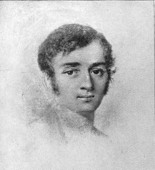
Jean-Nicolas Nicollet
In 1872, the mathematician Augustus De Morgan published
A Budget of Paradoxes in which he suggested that a French scientist,
Jean-Nicolas Nicollet, authored the lunar narrative. Nicollet was living in America at the time of the publication of the moon hoax, having left France, apparently because he was fleeing creditors. According to De Morgan:
"There is no doubt that it [the lunar narrative] was produced in the United States, by M. Nicollet, an astronomer, once of Paris, and a fugitive of some kind... The moon-story was written, and sent to France, chiefly with the intention of entrapping M. Arago, Nicollet's especial foe, into the belief of it. And those who narrate this version of the story wind up by saying that M. Arago was entrapped, and circulated the wonders through Paris, until a letter from Nicollet to M. Bouvard explained the hoax."
De Morgan offered no evidence to back up the theory of Nicollet's authorship, but the case for Nicollet was later taken up by S.A. Mitchell, in an
article in Popular Astronomy (1900). Mitchell argued that Locke simply didn't have the astronomical knowledge or creative skill necessary to have come up with the moon hoax:
Besides the great fluency of style and the masterful command of the English language shown by the 'Moon Hoax,' there is evinced in this article so accurate a knowledge of astronomical facts, even to the most scientific details, that it is evident none but an astronomer of more than ordinary ability could have written it. This Locke certainly was not. After severing his connection with the Sun, Locked edited the New Era, and soon after there appeared in this periodical another hoax, 'The Lost Manuscript of Mungo Park,' also by Locke. This, however, while showing the same peculiarities in style as the 'Moon Hoax,' lacked greatly the bold and daring conception in the plot of the latter, and as a result secured very little notoriety. It would seem, therefore, that there had been some bolder and more learned spirit than Locke's which had conceived the plot of the 'Moon Hoax,' and supplied the editor of the Sun with the astronomical facts necessary for the construction of the article... We seem to find this man in the person of M.J.N. Nicollet, a noted French astronomer, who, for some unknown causes, had been compelled to leave France and seek refuge in America.
This astronomer, in connection with MM. Brosseaud and Bouvard, was the author of an important memoir, 'Sur la Libration de la Lune'; and in Amer. Phil. Soc. Trans. Vol. VIII, 1842, pp. 306-310, we have a work of his published under the name of 'Observations made at several places in the United States.' With Nicollet as the author we find an explanation of the precise astronomical knowledge shown in our article, and especially the frequent use of the term 'libration' in his descriptions of the moon.
The problem with the theory of Nicollet's authorship is that it's unlikely that Nicollet, whose first language was French, could have written a text that displayed such a mastery of English. At the very least, he must have had someone (probably Locke) translate it. But there's no evidence that Locke and Nicollet ever met or communicated. Nor was Nicollet anywhere near New York in 1835. He was living in St. Louis.
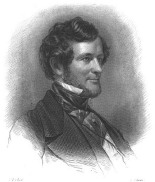
Lewis Gaylord Clark
Another theory, put forward by Benson Lossing in 1884 in his
History of New York City, was that Lewis Gaylord Clark, editor of the
Knickerbocker Magazine, helped Locke write the lunar narrative. Lossing wrote:
"Clark was the real inventor of the incidents, the imaginative part, while to Locke was intrusted the ingenious task of unfolding the discoveries. Messrs. Beach, Clark, and Locke were in daily consultation while the hoax was in preparation. It was thus a joint product."
The 'Beach' referred to by Lossing was Moses Beach, who purchased the
Sun from Benjamin Day in 1837. But in 1835, Beach wasn't involved with the
Sun, which suggests that Lossing's theory is mistaken. Also, it's not clear why Clark would have had a better knowledge of astronomy than Locke.
Overall, there's no compelling evidence to indicate that anyone but Locke wrote the moon hoax. After all, Locke confessed to it. Neither Nicollet nor Clark ever did. And Benjamin Day never hinted that anyone else might be involved. Nor did first-hand observers of the hoax, such as James Gordon Bennett and Edgar Allan Poe, ever suggest that they suspected anyone else's participation.
We can attribute Locke's knowledge of astronomy to his wide reading. As Goodman (2008) points out, even from a young age Locke demonstrated a "seemingly bottomless capacity for knowledge." He chose to become a writer, but he definitely had an aptitude for the sciences and scholarship, and he might have excelled in these fields if he had made different choices early in his career.
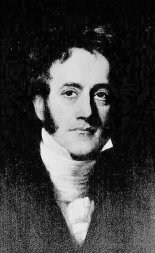
Sir John Herschel
An innocent victim of the moon hoax was Sir John Herschel, to whom the lunar discoveries were attributed. At the time of the publication of the lunar narrative, he was in South Africa, charting the stars of the Southern Hemisphere, unaware of the liberties being taken with his name.
According to William Griggs (1852), an American showman named Caleb Weeks, who traveled to Africa in late 1835 in order to collect animals for his New York menagerie, first presented the
Sun's lunar narrative to Herschel. Weeks handed the paper to Herschel, telling him only, in vague language, that it was an American paper containing a report of some of his "great astronomical discoveries." Herschel thanked Weeks for the gift, retired to his room in the Cape Town hotel where they both were staying, only to burst forth minutes later exclaiming, "This is a most extraordinary affair! Pray, what does it mean?"
After receiving a full description of the hoax, Herschel laughed and said he "feared the actual results of his telescopic observations at the Cape would be very humble, in popular estimation, at least, in comparison with those ascribed to him in the American account."
Herschel’s good humor concerning the hoax apparently didn't last too long. Two years later he complained in a letter to his Aunt Caroline, "I have been pestered from all quarters with that ridiculous hoax about the Moon — In English French Italian & German!!"
And in May 2001, an unsent letter was discovered in the private archives of Herschel's descendants. It was written by Herschel, dated 21 August 1836, and addressed to the editor of the
Athenaeum magazine. If published, it would have been Herschel's longest official response to the moon hoax:
Sir,
As I perceive by an Advertisement in one of the London Newspapers now before me that the nonsense alluded to in the heading of this letter after running the round of the American and French journals has at last found a London editor, it appears to me high time to disclaim all knowledge of or participation in the incoherent ravings under the name of discoveries which have been attributed to me. I feel confident that you will oblige me therefore by inserting this my disclaimer in your widely circulated and well conducted paper, not because I have the smallest fear that any person possessing the first elements of optical Science (to say nothing of Common Sense) could for a moment be misled into believing such extravagancies, but because I consider the precedent a bad one that the absurdity of a story should ensure its freedom from contradiction when universally repeated in so many quarters and in such a variety of forms. Dr. Johnson Indeed used to say that there was nothing, however absurd or impossible which if seriously told a man every morning at breakfast for 365 days he would not end in believing — and it was a maxim of Napoleon that the most effective figure in Rhetoric is Repetition. Now I should be sorry, for my own sake as well as for that of truth, that the world or even the most credulous part of it, should be brought to believe in my personal acquaintance with the man in the moon — well knowing that I should soon be pestered to death for private anecdotes of himself and his family, and having little intention and less inclination to humour the hoax, should come to be looked on as a very morose and uncommicative sort of person when it was found that I could or would say no more about him than what is already known to all the world — vis that he
'drinks claret'
'eats powdered beef turnip & carrot'
and that 'a cup of old Malaya Sack'
'Will fire the pack at his back.'
I am Sir
your obedient
John F. Wm Herschel
Feldhausen
Near Wynberg C.G.H.
- The text of Locke's lunar narrative was translated into many languages, including French, German, Italian, and Welsh. There was even a shorthand version of it, published in 1886.
Left: Shorthand edition of the moon hoax. Right: Welsh edition of the moon hoax.
- During the remainder of the nineteenth century, the moon hoax became a byword for deception. Anything suspicious would be compared to the moon hoax, or it might be called "moon hoaxy" — a term used by Poe in his short story Von Kempelen and his Discovery.
- During the nineteenth century, the moon hoax was popular enough to inspire the creation of various forms of moon-hoax-themed merchandise. For instance, the Nantucket Historical Association has what appears to be a fragment of Moon Hoax Wallpaper that decorated a house in Nantucket. And Oxford's Museum of the History of Science has a Moon Hoax Snuff Box.
- In 1891, when workmen were tearing down the old Brooklyn Institute Building, they discovered a lead box beneath the cornerstone. It had been placed there when the cornerstone was laid, on 31 October 1835. Upon opening the box, it was found to contain some coins, several newspapers dated 31 October 1835, and two large engravings of "Lunar animals and other objects discovered by Sir John Herschel in his observatory at the Cape of Good Hope."
- A complete copy of the original lunar narrative published in the Sun (not the pamphlet that the Sun subsequently published) was sold in July 1969 for $160. It was bought by Walter R. Benjamin, an autograph dealer, on behalf of a private client. In December 2011, a set of the articles was offered for sale on eBay for $488.
- Griggs, W.N. (1852), The Celebrated 'Moon Story,' Its Origin And Incidents. New York: Bunnell & Price.
- Locke, R.A. (1859), The Moon Hoax; or, A Discovery that the Moon has a vast population of human beings. New York: William Gowans.
- De Morgan, A. (1872), A Budget of Paradoxes. London: Longmans, Green, and Co.
- Proctor, R.A. (July/Oct 1876), "The Lunar Hoax," Belgravia: An Illustrated London Magazine, 30: 177-194.
- Mitchell, S.A. (May 1900), "The Moon Hoax", Popular Astronomy, 8(5): 256-267.
- O'Brien, F.M. (1928), The Story of The Sun. New York: D. Appleton and Company.
- Barton, W.H. (Feb 1937), "The Moon Hoax: The Greatest Scientific Fraud Ever Perpetrated," Sky, 1: 6-10, 22; March 1937: 10-11, 23-5; April 1937: 10-11, 22-4, 28.
- Reaves, G. (Nov 1954), "The Great Moon Hoax of 1835," The Griffith Observer, 17(11): 126-134.
- Price, G.R. (July 1958), "The Day they Discovered Men on the Moon." Popular Science, 173: 61-64.
- Ley, W. (1963), Watchers of the Skies: An Informal History of Astronomy from Babylon to the Space Age. London: Sidgwick & Jackson Ltd.
- Morrison, J.L. (1969), "A View of the Moon from the Sun: 1835." American Heritage. 20(3): 80-82.
- Seavey, O. ed. (1975), The Moon Hoax, Or, A Discovery That The Moon Has A Vast Population of Human Beings. Boston: Gregg Press.
- Evans, D.S. (Sep 1981), 'The Great Moon Hoax', Sky and Telescope: 196-198; Oct 1981: 308-311.
- Crowe, M.J. (Nov. 1981), "New Light on the Moon Hoax", Sky and Telescope: 428-429.
- Crowe, M.J. (1986), The Extraterrestrial Life Debate, 1750-1900. New York: Cambridge University Press.
- Cohan, P. (Apr/May 1986), "Heavenly Hoax", Air & Space Smithsonian, 1(1): 86-95.
- Fernie, D.J. (Mar/Apr 1993), "The Great Moon Hoax", American Scientist, 81: 120-122.
- Crowe, M.J. (June 1997), 'A History of the Extraterrestrial Life Debate', Zygon, 32(2): 147-162.
- Ruskin, S.W. (2002), 'A Newly-Discovered Letter of J.F.W. Herschel Concerning the Great Moon Hoax', Journal for the History of Astronomy, 33: 71-74.
- Copeland, D.A. (Fall 2007), 'A Series of Fortunate Events: Why People Believed Richard Adams Locke's Moon Hoax', Journalism History, 33(3): 140-150.
- Goodman, M. (2008), The Sun and the Moon: The Remarkable True Account of Hoaxers, Showmen, Dueling Journalists, and Lunar Man-Bats in Nineteenth-Century New York. New York: Basic Books.
- Castagnaro, M. (2009), Embellishment, Fabrication, and Scandal: Hoaxing and the American Press. Carnegie Mellon University. Ph.D. Dissertation.

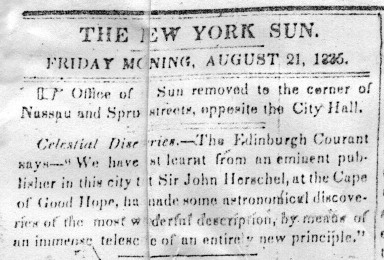





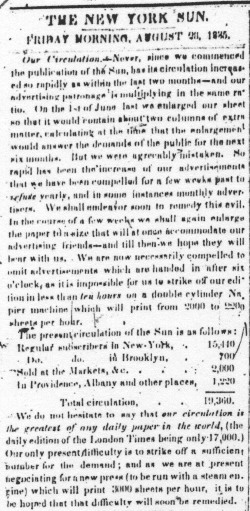










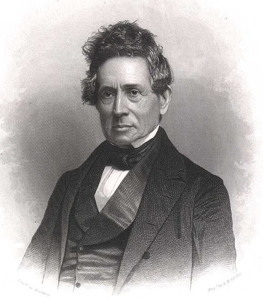





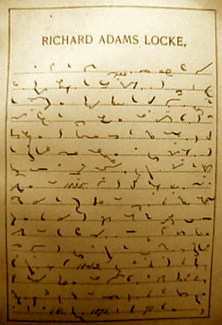
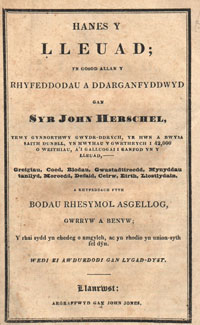
The Great Moon Hoax